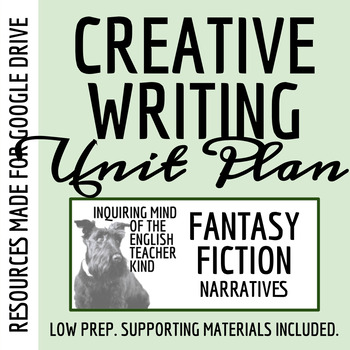Creative Writing Unit Plan for Fantasy Fiction and Tall Tales (Google Drive)
Inquiring Mind of the English Teacher Kind
1.2k Followers
Grade Levels
9th - 12th
Subjects
Resource Type
Standards
CCSSRL.9-10.1
CCSSRL.9-10.2
CCSSRL.9-10.3
CCSSRL.9-10.4
CCSSRL.9-10.5
Formats Included
- Google Drive™ folder
Pages
40+
Inquiring Mind of the English Teacher Kind
1.2k Followers

Made for Google Drive™
This resource can be used by students on Google Drive or Google Classroom. To access this resource, you’ll need to allow TPT to add it to your Google Drive. See our FAQ and Privacy Policy for more information.
What educators are saying
My students loved this resource. They followed it easily and it fueled thier imaginations to compose their own stories.
Also included in
- This bundle includes a full semester curriculum map; six three-week, standards-based unit plans; and all instructional materials for supporting high school Creative Writing students as they generate original works of fiction. Not only does this bundle provide everything a teacher needs to carry outPrice $100.00Original Price $191.50Save $91.50
Description
Save time without sacrificing rigor in the high school Creative Writing classroom with this Common Core-aligned unit plan and these comprehensive, low-prep materials for engaging students fully in the narrative writing process. Materials are made for Google Drive. (Alternatively, printable versions are available.) Included are the following:
- A detailed, standards-based unit plan articulating the unit's transfer goal(s), essential question(s), enduring understanding(s), learning target(s), academic vocabulary, formative assessment(s), summative performance task(s), and learning plan(s)
- A Google Slideshow addressing the conventions of the fantasy genre.
- Representative fantasy narratives ("The Wife's Story" by Ursula K. Le Guin, "The Chaser" by John Collier, and "The Devil and Daniel Webster" by Stephen Vincent Benet)
- Worksheets to facilitate analysis of representative literature
- Detailed directions
- A comprehensive outline for student planning
- A document to facilitate the editing process
- A comprehensive rubric for evaluating student writing
With these materials, students will do the following:
- Develop greater understanding of the conventions of the fantasy genre.
- Analyze how John Collier used figurative language (simile, metaphor, and euphemism), characterization, direct description, and foreshadowing to generate a compelling fantasy narrative in "The Chaser."
- Analyze how Ursula K. Le Guin used characterization and grammatically improper language to develop an anthropomorphized protagonist in "The Wife's Story."
- Develop a greater understanding of how Stephen Vincent Benet used hyperbole, simile, metaphor, and other literary devices to convey an exaggerated narrative in "The Devil and Daniel Webster" that is consistent with the supernatural fiction and tall tales.
- Organize initial ideas in a coherent manner.
- Engage the reader with a compelling exposition that establishes setting, characters, and conflicts
- Use many appropriate narrative techniques (dialogue, dialect, description, pacing, etc.) to enhance a plot that is consistent with the fantasy genre
- Draft a coherent, cohesive, and appropriate narrative that builds toward a particular tone and outcome (a sense of mystery, suspense, etc.)
- Use precise words and phrases, active verbs, and sensory language to convey a compelling story
- Draft a reasonable and unrushed conclusion that resolves conflicts and conveys a theme
- Show mastery of the conventions of standard English grammar, usage, capitalization, punctuation, and spelling.
Unit plans are available for a variety of writing tasks:
- Writing Adventure Fiction - Google and printable versions
- Writing Dinosaur Tales - Google and printable versions
- Writing Fairy Tales - Google and printable versions
- Writing Fantasy Fiction - Google and printable versions
- Writing Gothic Fiction - Google and printable versions
- Writing Realistic Fiction - Google and printable versions
- Writing Science Fiction - Google and printable versions
Total Pages
40+
Answer Key
Included with rubric
Teaching Duration
3 Weeks
Last updated Jan 14th, 2021
Report this resource to TPT
Reported resources will be reviewed by our team. Report this resource to let us know if this resource violates TPT’s content guidelines.
Standards
to see state-specific standards (only available in the US).
CCSSRL.9-10.1
Cite strong and thorough textual evidence to support analysis of what the text says explicitly as well as inferences drawn from the text.
CCSSRL.9-10.2
Determine a theme or central idea of a text and analyze in detail its development over the course of the text, including how it emerges and is shaped and refined by specific details; provide an objective summary of the text.
CCSSRL.9-10.3
Analyze how complex characters (e.g., those with multiple or conflicting motivations) develop over the course of a text, interact with other characters, and advance the plot or develop the theme.
CCSSRL.9-10.4
Determine the meaning of words and phrases as they are used in the text, including figurative and connotative meanings; analyze the cumulative impact of specific word choices on meaning and tone (e.g., how the language evokes a sense of time and place; how it sets a formal or informal tone).
CCSSRL.9-10.5
Analyze how an author’s choices concerning how to structure a text, order events within it (e.g., parallel plots), and manipulate time (e.g., pacing, flashbacks) create such effects as mystery, tension, or surprise.






